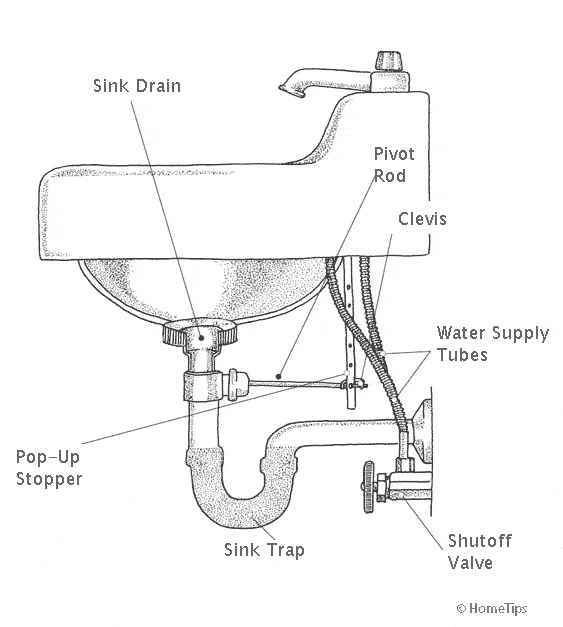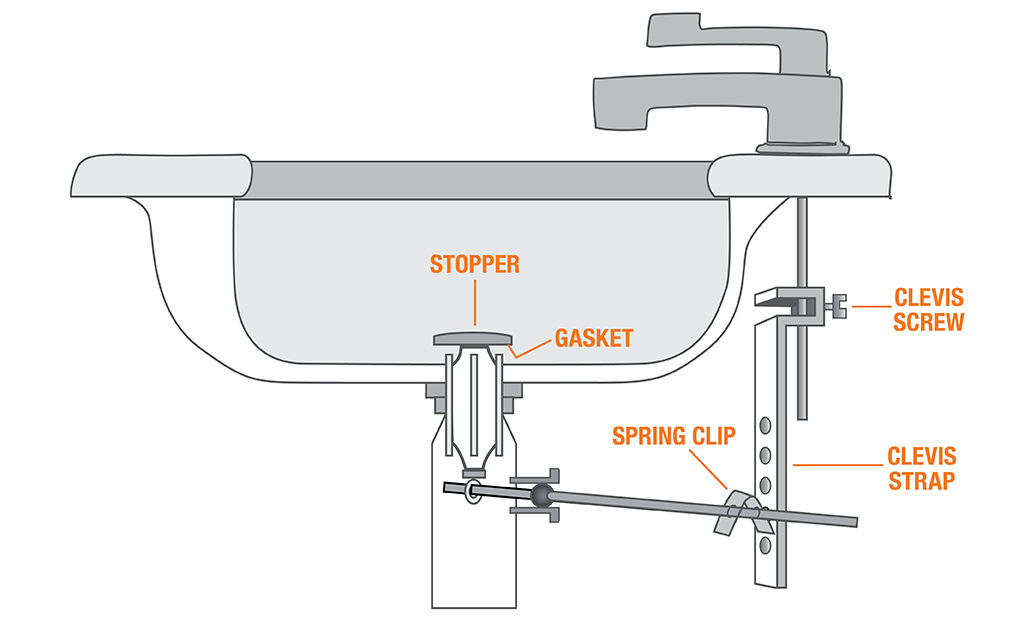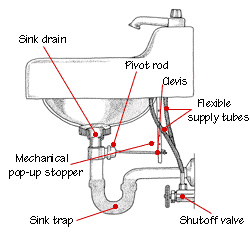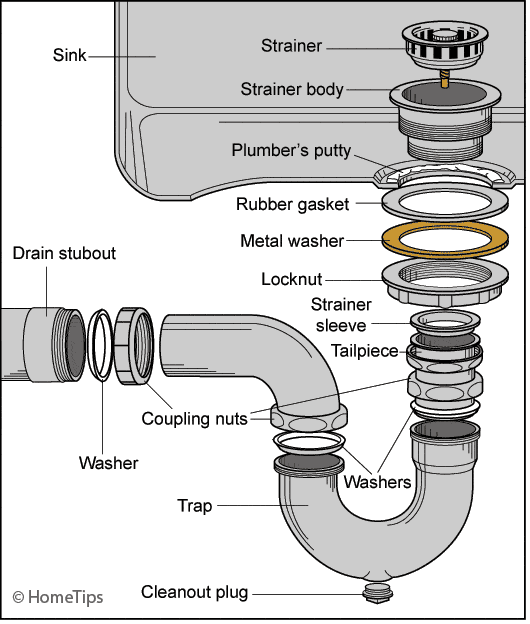Understanding the various components of a bathroom sink is crucial when it comes to maintenance, repairs, or even choosing the right sink for your bathroom renovation project. In this comprehensive guide, we’ll explore a bathroom sink parts diagram to provide you with a better understanding of the sink’s anatomy.
Sink Bowl: The sink bowl is the primary basin where water and waste are collected. It comes in various shapes and sizes, from round and oval to rectangular and square, and is typically made of materials like porcelain, ceramic, or stainless steel. The bowl is the most visible part of the sink and plays a crucial role in defining the sink’s style and functionality.
Faucet: The faucet is the fixture that controls the flow of water into the sink. It typically consists of a spout, handles, and various internal components. The handles are used to adjust the water temperature and flow. Modern faucets come in various styles, including single-handle, double-handle, and even touchless options. Understanding the type of faucet you have is essential for maintenance and potential replacements.
Drain Assembly: The drain assembly is responsible for allowing water to exit the sink while preventing debris from clogging the plumbing system. It consists of several parts, including the drain flange, stopper, and P-trap. The drain flange is the visible piece in the bottom of the sink, and it’s usually connected to the stopper rod. The P-trap, a curved pipe, prevents sewer gases from entering your bathroom by creating a water seal. Regular maintenance of the drain assembly is essential to prevent blockages.
Overflow Hole: Many bathroom sinks have an overflow hole, a small opening near the top of the sink bowl. It serves as a secondary drainage system, preventing the sink from overflowing in case the main drain is blocked or the faucet is left running. Understanding the position and function of the overflow hole can be vital for troubleshooting issues related to sink drainage.
Pop-Up Stopper: The pop-up stopper is a common type of drain stopper used in bathroom sinks. It’s operated by a lift rod connected to the faucet. When you lift the rod, it opens the stopper to allow water to drain, and when you push it down, it seals the drain to fill the sink. Understanding how the pop-up stopper operates is crucial for keeping your sink working smoothly and for addressing any issues related to stopper functionality.
Having a solid grasp of the various components in a bathroom sink is valuable for homeowners and DIY enthusiasts. It enables you to identify and troubleshoot common sink-related issues and make informed decisions when it comes to sink maintenance or upgrades. Whether it’s the sink bowl, faucet, drain assembly, overflow hole, or pop-up stopper, each part plays a crucial role in the sink’s overall functionality and aesthetics. So, the next time you encounter a sink problem or decide to replace your bathroom sink, you’ll be better equipped to navigate the intricacies of its components
Repair Parts – The Sink Factory
Bathroom sinks can go a far way inside remodeling your bathroom. It provides the bathroom some form of space feel that is open because of the unenclosed sink. You are able to buy sinks that sit along with a vanity, similar to a bowl would. You are able to make go with a vessel sink to make a daring decorative statement.
Parts of a Sink
Bathroom Sink Plumbing Diagram DIY Pinterest Sinks Bathroom sink
Not a good choice if you have kids who’ll be making use of the bathroom sink. There are also a wide variety of shapes also including curved and various and angular styles ranging from the ultra chic to something more classic. Instead of choosing dirt and grime stuck in the sealant around the sink, the basin is connected beneath the kitchen counter surface and does not have noticeable seams.
Kitchen Sink Drain Parts: Diagram, Pictures, Installation
Parts of a Sink
Bathroom Faucet Bathroom Sink Parts Diagram Faucet Parts Diagram
Bathroom Sink Plumbing
Bathroom Sink Drain Parts
Bathroom Sink Drain Parts: Diagrams and Installation – Plumbing Sniper
15 Parts of a Kitchen Sink (with a 3D Illustrated Diagram) – Homenish
The 16 Parts of a Kitchen Faucet (Diagram) – Home Stratosphere
Faucet Drain Diagram A device installed under the sink between the
Related articles:
- Bathroom Sink Cabinets Modern
- Rustic Bathroom Sink Ideas
- Bathroom Sink Storage Ideas
- Farmhouse Bathroom Sink Ideas
- Bathroom Sinks Blue
- Bathroom Sink 400mm
- Ada Bathroom Sink Dimensions
- Bathroom Sink Marble Countertop
- Bathroom Sink Design Ideas
- Bathroom Sink Pipe Leak Repair
Bathroom Sink Parts Diagram: A Comprehensive Guide for Homeowners
When it comes to plumbing, one of the most important areas of your home is the bathroom sink. The sink is responsible for disposing of waste, providing clean water for washing and bathing, and ensuring that your bathroom stays sanitary and hygienic. In order to keep your bathroom sink functioning correctly, it is important to understand the various parts that make up a bathroom sink and their purpose. This article will provide a comprehensive guide to bathroom sink parts diagrams, helping you to become more knowledgeable about your home’s plumbing system.
What is a Bathroom Sink Parts Diagram?
A parts diagram is a drawing that outlines the components of an object in detail. In this case, we will be looking at the parts of a bathroom sink. A parts diagram will show you everything from the faucet to the drain pipe, along with all other associated pieces. By studying a parts diagram and familiarizing yourself with its components, you can better understand how each part functions and how they all work together to form a cohesive whole.
Components of a Bathroom Sink Diagram
The following are some of the most common components found in a bathroom sink parts diagram:
Faucets
The faucet is the main component of any sink and is responsible for controlling the flow of water. Faucets come in many different shapes and sizes and are available in both single-handle and two-handle designs. They can also feature several different functions such as sprayer heads or temperature control knobs.
Pipes
Pipes are responsible for carrying water into and out of the sink. They are typically made from copper or PVC materials and come in various lengths depending on the size of your sink basin. Pipes can also feature several different types of connections such as compression fittings or slip joints.
Drain Trap
The drain trap is responsible for preventing sewer gas from entering your home’s air supply. It is typically made from PVC material and consists of two pipes: one leading into the wall and one leading up into the drainpipe. The trap also contains a U-shaped portion which traps water inside, thus creating a seal against sewer gas seeping through.
Supply Lines
Supply lines are responsible for carrying cold and hot water from their respective water sources (such as a hot water heater) into your sink’s faucet. They can be made from either metal or plastic materials depending on their intended use, but all supply lines must be able to withstand high temperature levels in order to function correctly.
Overflow Tube
The overflow tube is designed to prevent water from spilling over onto your floor in case there is ever an issue with clogged drains or faulty drainage systems. It is typically made from PVC material and connected directly to your drainpipe via a compression fitting or slip joint connection.
FAQs About Bathroom Sink Parts Diagrams
Q: What type of material should I use for my pipes?
A: The type of material you should use for your pipes depends on what type of plumbing system you have installed in your home. Generally speaking, copper pipes are ideal for older homes that may still be using galvanized steel piping while PVC pipes are better suited for newer homes that have been built within the last few decades. It is always best to consult with an experienced plumber before making any decisions regarding pipe materials so that you can ensure that your plumbing system is up to code and functioning properly at all times.
Q: Can I install my own bathroom sink?
A: Installing a bathroom sink can be tricky if you do not have any prior experience with plumbing work, but it is definitely possible if you take the time to carefully read through the instructions provided by the manufacturer or consult with an experienced plumber beforehand. You will need access to basic tools such as an adjustable wrench, pliers, screwdrivers, pipe wrenches, etc., as well as some knowledge regarding how each component works together in order to complete this task successfully on your own without any assistance from an outside source.
What are the different types of bathroom sink parts?
1. Drain Assembly: This includes the sink drain, tailpiece, P-trap, and supply lines.
2. Faucet: Includes the faucet body, handles, escutcheons, and spout.
3. Pop-up Stopper: The pop-up stopper connects to the faucet body and is used to stop water from flowing out of the sink.
4. Sink Strainer: Installed in the sink drain to prevent debris from entering the drain pipes.
5. Supply Lines: Flexible hoses that connect the sink to the shutoff valves under the sink or in the wall.
6. Shutoff Valves: Used to turn off water supply to the sink when needed.
What are the different types of sink drains?
1. Pop-up Drains: These drains feature a stopper that is manually operated, usually with a lever or knob on the sink.
2. Basket Strainers: These strainers are commonly used in kitchen sinks to capture debris before it enters the drain line. The strainer is typically a removable basket that sits inside the drain opening.
3. Push-Button Drains: These drains feature a stopper that is operated by pressing a button on the sink or countertop.
4. Automatic Drains: These drains feature a float mechanism that triggers the stopper to open and close when water levels rise and fall.
5. Air Gaps: An air gap is an additional plumbing component typically required by code in some areas for dishwashers and other appliances connected to the sink drain. An air gap prevents contamination of clean water supplies by allowing air to flow between the appliance’s discharge line and the sink’s drain line, preventing backflow.













